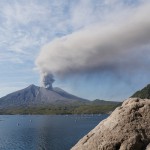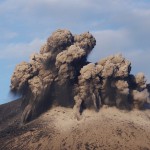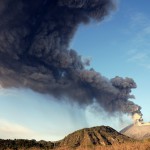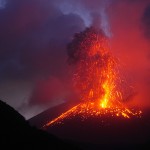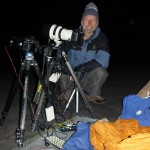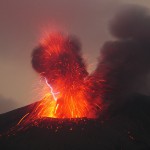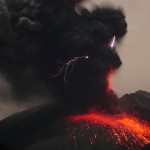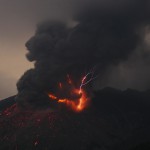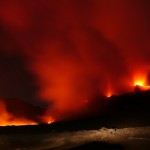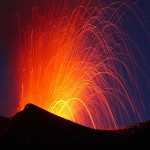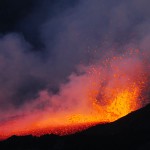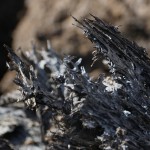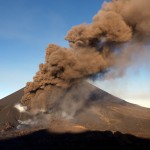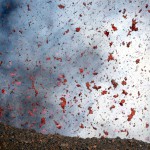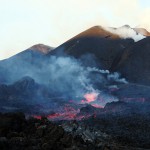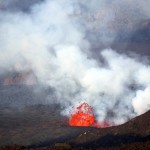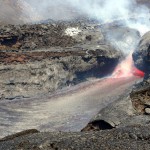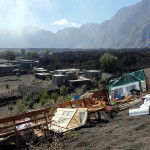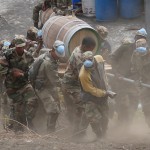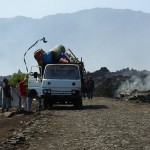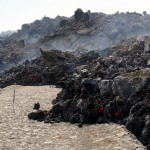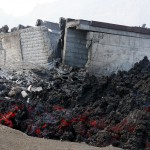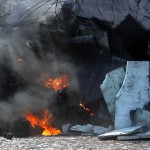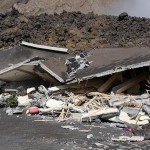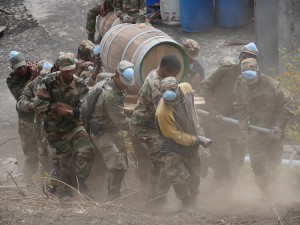Volcanic lightning on Sakurajima in Japan. The lightning occurs in ash-rich eruptions, mostly during first 20 seconds of the eruption. I saw a shock wave in one of the first morning of my observations in March 2015. This shock wave you will see in the video.
The story of volcanic lightning
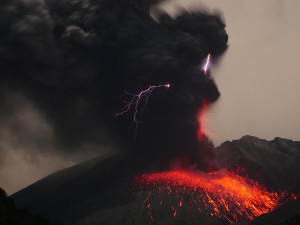 I visited the Sakurajima in Japan several times in the past years: the volcanic lightning in the ash clouds always attracted me like a magnet! Photographing at the volcano is never easy, but to capture flash clouds requires special know-how and a lot of patience. I was on the road again with Martin Rietze and after the long flight we went straight to the volcano in the evening after our arrival in Kagoshima. We wanted to spend the night at our favorite place again and set up our cameras. It is about 3 km from the summit of Sakurajima, almost at the end of a small road leading to a lahar dam. But, oh dear, the property with the meadow was fenced in and the meadow was nice and clean and the ground was levelled. What now? With a bad conscience we bypassed the fence and set up our camp at the edge of a bush.
I visited the Sakurajima in Japan several times in the past years: the volcanic lightning in the ash clouds always attracted me like a magnet! Photographing at the volcano is never easy, but to capture flash clouds requires special know-how and a lot of patience. I was on the road again with Martin Rietze and after the long flight we went straight to the volcano in the evening after our arrival in Kagoshima. We wanted to spend the night at our favorite place again and set up our cameras. It is about 3 km from the summit of Sakurajima, almost at the end of a small road leading to a lahar dam. But, oh dear, the property with the meadow was fenced in and the meadow was nice and clean and the ground was levelled. What now? With a bad conscience we bypassed the fence and set up our camp at the edge of a bush.
Already in the first night our patience was put to the test: the volcano was unusually quiet and produced only a few miserable ash clouds, so completely without lightning. Then in the morning, all the accumulated energy was discharged in a proper detonation! The generated shock wave was not only visible in the clouds above the crater, but could also be clearly felt as a short shock wave. After the lame night it got us going. But unfortunately the weather got worse and worse and we decided to break up our camp and set off for the volcano Aso. This volcano is about 2 hours drive away from Sakurajima. Aso was strombolian active in the last weeks and especially Martin heard its tempting call.
But, how could it be different, the bad weather reached the volcano with us. Shortly before the clouds closed, we caught a glimpse of the crater and a small ash cloud, then it started to rain. We explored the visitor center at the foot of the crater cone. The ascent to the crater was of course closed. I was quite surprised about the size of the parking lot: in summer there must have been a lot going on here! Well, the Japanese love and adore their volcanoes and like to go hiking there.
In the evening it started snowing and Martin and I spent an uncomfortable night in the car, without any volcano view. Since we had little time, we started the next morning to Sakurajima. We made a short side trip to the Kirishima volcano. There the weather was better and the volcanic landscape was impressive! If the volcano should become active again, you have to go there!
On the way to Sakurajima we stormed a supermarket: the prices in Japan are sometimes enormous! Instead of being self-sufficient, you can better go to one of the few fast food restaurants or buy ready-made schnitzels in a minimarket.
In the evening we took position at Sakurajima again. But also this night was quite quiet. In the morning we had another nice eruption, this time with better weather!
Slowly our time was running out, but the next night we should have more luck. Saku turned up and produced 2 eruptions with volcanic lightning shortly after each other. Our cameras rattled in continuous mode and hardly a flash of lightning slipped through our fingers. In the air was the rumbling of the eruptions and the crackling of electrical discharges that made the hairs on your neck stand up. We looked through our cameras almost euphorically and hoped for more, but no more flashes. That’s how it is at the volcano! You often need a lot of patience for a few precious moments of successful experience.
